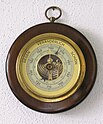The standard atmosphere (symbol: atm) is a unit of pressure defined as 101325 Pa. It is sometimes used as a reference pressure or standard pressure. It is approximately equal to Earth's average atmospheric pressure at sea level.[1]
| Atmosphere | |
|---|---|
| Unit of | Pressure |
| Symbol | atm |
| Conversions | |
| 1 atm in ... | ... is equal to ... |
| SI units | 101.325 kPa |
| US customary units | 14.69595 psi |
| other metric units | 1.013250 bar |

History
editThe standard atmosphere was originally defined as the pressure exerted by a 760 mm column of mercury at 0 °C (32 °F) and standard gravity (gn = 9.80665 m/s2).[2] It was used as a reference condition for physical and chemical properties, and the definition of the centigrade temperature scale set 100 °C as the boiling point of water at this pressure. In 1954, the 10th General Conference on Weights and Measures (CGPM) adopted standard atmosphere for general use and affirmed its definition of being precisely equal to 1013250 dynes per square centimetre (101325 Pa).[3] This defined pressure in a way that is independent of the properties of any particular substance. In addition, the CGPM noted that there had been some misapprehension that the previous definition (from the 9th CGPM) "led some physicists to believe that this definition of the standard atmosphere was valid only for accurate work in thermometry."[3]
In chemistry and in various industries, the reference pressure referred to in standard temperature and pressure was commonly 1 atm (101.325 kPa) prior to 1982, but standards have since diverged; in 1982, the International Union of Pure and Applied Chemistry recommended that for the purposes of specifying the physical properties of substances, standard pressure should be precisely 100 kPa (1 bar).[4]
Pressure units and equivalencies
edit| Pascal | Bar | Technical atmosphere | Standard atmosphere | Torr | Pound per square inch | |
|---|---|---|---|---|---|---|
| (Pa) | (bar) | (at) | (atm) | (Torr) | (lbf/in2) | |
| 1 Pa | — | 1 Pa = 10−5 bar | 1 Pa = 1.0197×10−5 at | 1 Pa = 9.8692×10−6 atm | 1 Pa = 7.5006×10−3 Torr | 1 Pa = 0.000145037737730 lbf/in2 |
| 1 bar | 105 | — | = 1.0197 | = 0.98692 | = 750.06 | = 14.503773773022 |
| 1 at | 98066.5 | 0.980665 | — | 0.9678411053541 | 735.5592401 | 14.2233433071203 |
| 1 atm | ≡ 101325 | ≡ 1.01325 | 1.0332 | — | 760 | 14.6959487755142 |
| 1 Torr | 133.322368421 | 0.001333224 | 0.00135951 | 1/760 ≈ 0.001315789 | — | 0.019336775 |
| 1 lbf/in2 | 6894.757293168 | 0.068947573 | 0.070306958 | 0.068045964 | 51.714932572 | — |
A pressure of 1 atm can also be stated as:
- ≈ 1.033 kgf/cm2
- ≈ 10.33 m H2O[5]
- ≈ 760 mmHg[6]
- ≈ 29.92 inHg[6]
- ≈ 406.782 in H2O[5]
- ≈ 2116.22 pounds-force per square foot (lbf/ft2)
The notation ata has been used to indicate an absolute pressure measured in either standard atmospheres (atm)[7][better source needed] or technical atmospheres (at).[8]
See also
editReferences
edit- ^ "Water Pressures at Ocean Depths". NOAA Pacific Marine Environmental Laboratory. Retrieved 11 October 2022.
- ^ Resnick, Robert; Halliday, David (1960). Physics for Students of Science and Engineering Part 1. New York: Wiley. p. 364.
- ^ a b "BIPM - Resolution 4 of the 10th CGPM". www.bipm.org.
- ^ IUPAC.org, Gold Book, Standard Pressure
- ^ a b As a unit of measurement, the conventional metre of water (mH2O) is defined as an ideal column of water with density of 1000 kg/m3 under standard gravity gn of 9.80665 m/s2 i.e. 1 m × 1000 kg/m3 × 9.80665 m/s2 = 9806.65 Pa (though in practice the density of pure water is always less). 1 cmH2O = 0.01 mH2O and 1 inH2O = 0.0254 mH2O. BS 350:Part 1:1974 Conversion factors and tables, Part 1. Basis of tables. Conversion factors. British Standards Institution. 1974. p. 49.
- ^ a b As a unit of measurement, the conventional millimetre of mercury (mmHg) is defined as an ideal column of mercury with density of 13595.1 kg/m3 under standard gravity gn of 9.80665 m/s2 i.e. 0.001 m × 13595.1 kg/m3 × 9.80665 m/s2 ≈ 133.322 Pa. 1 inHg = 25.4 mmHg. BS 350:Part 1:1974 Conversion factors and tables, Part 1. Basis of tables. Conversion factors. British Standards Institution. 1974. p. 49.
- ^ "The Difference Between An ATM & An ATA". Scuba Diving & Other Fun Activities. March 2, 2008.
- ^ BS 350:Part 1:1974 Conversion factors and tables, Part 1. Basis of tables. Conversion factors. British Standards Institution. 1974. p. 50.